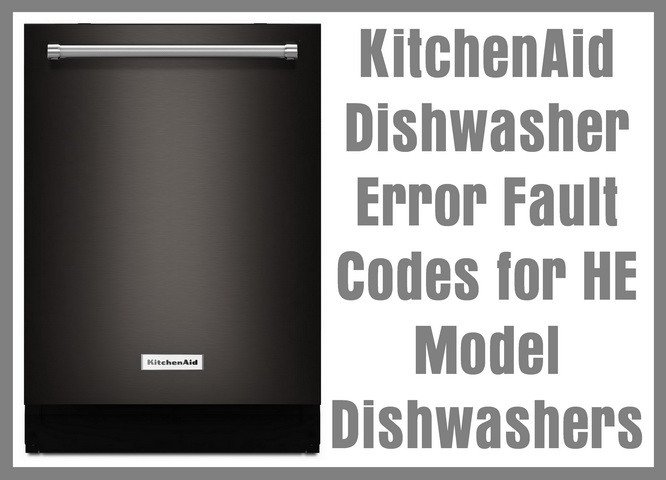
In today’s tech-savvy world, many appliances come with error codes to help diagnose what’s going wrong. Think of these codes like the “check engine” light in your car; they’re there to guide you toward the problem. In the case of your KitchenAid dishwasher, encountering an E2 error code usually indicates an issue with the dishwasher’s water drainage. In simpler terms, your dishwasher is having trouble getting rid of the water after a wash cycle.
Understanding Error Code E2
Error codes can seem a bit cryptic, but they’re essentially trying to communicate a specific message about what’s going on inside your appliance. The E2 code on a KitchenAid dishwasher is like a small red flag indicating a possible drainage issue. Imagine trying to drain a bathtub with a clogged plug — the water just won’t go away. It’s similar to what your dishwasher is experiencing when the E2 code blinks at you.
This error often happens when something like food scraps or debris gets stuck in the dishwasher’s filter or drain hose. Imagine if you washed dishes in a sink without scraping off the leftover food first; those bits can end up stuck in the drain, causing water to back up. A similar thing can happen inside your dishwasher, preventing it from draining properly. If the water can’t exit, the dishwasher halts the cycle as a safety measure and alerts you with the E2 code.
So, what’s next? You’ll need to check a few key areas of the dishwasher. It’s not a daunting task. In fact, with a little bit of patience and basic tools, many people find they can handle the situation themselves. You just need to know where to look and what to look for.
Identifying the Cause of E2
Okay, so let’s dive into figuring out the exact cause of that pesky E2 error. Start by investigating the dishwasher’s filter. This is typically found at the bottom of the machine. Think of the filter as a catcher’s mitt for stray food particles. If it’s clogged, water can’t move freely through the appliance. Carefully remove the filter and give it a good clean in warm, soapy water.
Next, check the drain hose connected to the dishwasher. This hose is like a highway for wastewater, leading it away from the machine. Over time, it can become kinked or clogged with residue. When inspecting it, make sure the hose is free of any twists or blockages. If you find any debris, a gentle cleaning will often do the trick.
Finally, let’s consider the garbage disposal if your dishwasher is connected to one. Sometimes, a new installation or recent clog in the disposal can block the dishwasher’s ability to drain. Resetting or cleaning the connection point can sometimes resolve the E2 code.
Steps to Fix the E2 Error
Now that you have a good sense of what might be causing the E2 code, let’s walk through the steps you can take to fix it. First things first, always start by turning off the power to your dishwasher. This is both a safety precaution and a reset method. Unplug the machine or switch off the circuit breaker that supplies power to it.
With the power off, open the dishwasher door to gain access to its internal components. Check the filter and clean it thoroughly, removing any gunk you come across. Reinstall the filter once it’s sparkling clean. Next, pull out the dishwasher slightly so you can access the drain hose at the back. Ensure it’s not pinched or kinked and that it’s firmly connected. Run a small amount of water through it to check for clogs.
Finally, if the dishwasher is hooked up to a garbage disposal, run the disposal for a moment to clear any potential blockage. Before you turn the dishwasher back on, reset the machine by holding down the start button for a few seconds or until you hear a beep. Then, restore power to see if the error resolves.
Preventing Future E2 Errors
Let’s talk about prevention — nobody wants to deal with pesky error codes regularly. Luckily, keeping an E2 at bay can be pretty straightforward with a few simple habits. It’s all about regular maintenance and a little bit of foresight.
Start by being mindful of what goes into your dishwasher. Rinse off large food particles from your dishes before loading them in. While modern dishwashers can handle a bit of grime, large bits are best tossed in the trash or compost. Think of it as giving your dishwasher a head start, similar to stretching before exercise.
Regularly clean the filter, ideally once a month, to ensure it’s free of debris. This small step can make a big difference in keeping the drain clear. If your unit connects to a garbage disposal, avoid stuffing the disposal with fibrous or starchy foods that can lead to clogs, as they can indirectly affect your dishwasher’s drainage.
By spending just a few extra minutes here and there on these practices, you can keep your KitchenAid dishwasher running smoothly and error-free. If you ever encounter an E2 error again, you’ll be well-prepared and know exactly what to do. Remember, it’s all about keeping things flowing smoothly.